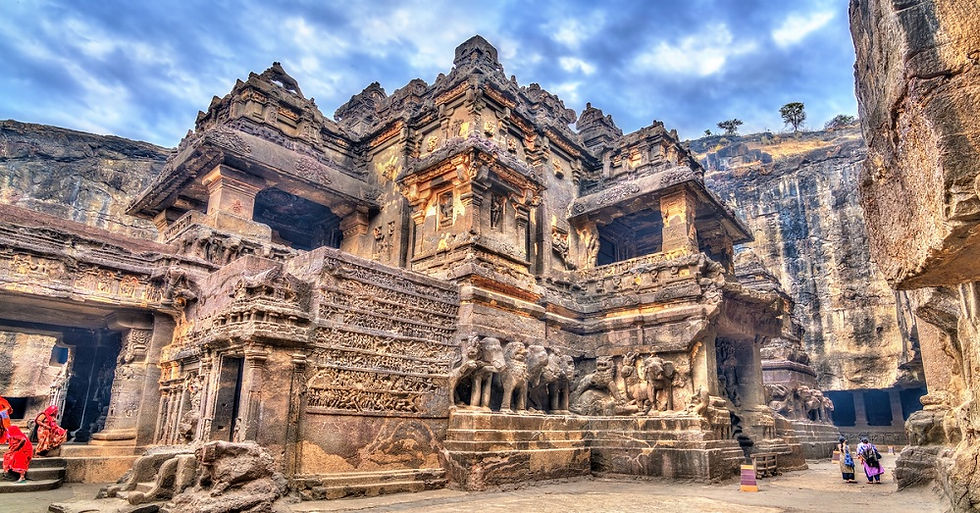Ajanta Ellora Caves: Ancient Marvels of India
- getsholidaysmci
- Jun 3
- 3 min read

The Ajanta Ellora Caves are among the most extraordinary examples of rock-cut architecture and ancient Indian art, drawing history enthusiasts, pilgrims, and travelers from around the world. Located in Maharashtra, these caves are UNESCO World Heritage Sites and represent the pinnacle of craftsmanship, spiritual expression, and storytelling through stone.
About Ajanta Ellora Caves
The Ajanta and Ellora Caves together form a monumental legacy that spans different religious faiths — Buddhism, Hinduism, and Jainism. While Ajanta showcases serene Buddhist monasteries and prayer halls carved into a horseshoe-shaped cliff, Ellora is famed for its diversity, featuring structures from all three major Indian religions. The Ajanta Ellora Caves history stretches back to as early as the 2nd century BCE and continued to evolve till about the 10th century CE, making them vital chronicles of India’s cultural and religious development.
Ajanta Caves: A Journey Through Serenity
When you visit Ajanta Caves, you step into a peaceful realm of ancient Buddhist thought and meditative art. The Ajanta complex consists of 30 caves, most of which were used as viharas (monasteries) and chaityas (prayer halls) by monks. These caves are carved into the Sahyadri hills and overlook the Waghur River, adding natural tranquility to the experience.
One of the most striking features is the Ajanta and Ellora Caves paintings, especially those found in Ajanta. These murals, painted using natural pigments, depict scenes from the Jataka tales — stories of Buddha’s previous lives. The delicate expressions, graceful forms, and narrative brilliance of the paintings remain unmatched in Indian art. These masterpieces form the foundation of Ajanta Caves information passed down through centuries and are a key attraction for art historians and spiritual seekers alike.
Ellora Caves: A Celebration of Diversity
An Ellora Caves tour introduces you to 34 caves that stand as a symbol of religious harmony. Cave 16, the stunning Kailasa Temple, is undoubtedly the highlight. This magnificent structure was carved from a single rock and dedicated to Lord Shiva. The temple features intricately carved sculptures, towering pillars, and grand courtyards — all testifying to the remarkable skill of ancient Indian artisans.
Unlike Ajanta, Ellora is more dynamic in style and structure, displaying architectural elements from Buddhism (Caves 1–12), Hinduism (Caves 13–29), and Jainism (Caves 30–34). This blend not only reflects the evolving religious landscape but also a society that respected and integrated different belief systems.
The Spiritual and Artistic Essence
The Ajanta Ellora Caves tour is more than a sightseeing trip — it's a spiritual journey through India's artistic soul. From the calm and introspective murals of Ajanta to the bold and majestic carvings of Ellora, every element reveals stories of faith, devotion, and artistic innovation.
Pilgrims often visit the Ajanta temple caves to pay homage, while travelers admire the remarkable preservation of some of the oldest surviving Indian paintings and sculptures. The caves were rediscovered by British officers in the 19th century, and since then, they’ve remained a subject of fascination for global scholars and tourists.
Planning Your Ajanta Ellora Tour
A well-planned Ajanta Ellora tour usually starts from Aurangabad, the nearest city with good rail, road, and air connectivity. It's ideal to dedicate at least two full days — one for Ajanta and one for Ellora — to fully absorb their beauty and history. Guided tours are available, offering deep insights into the symbolism and structure of the caves.
If you’re keen to learn about Ajanta Ellora Caves in detail, visiting with a guide or using an audio tour can help uncover the meanings behind the murals, sculptures, and religious references etched into stone. For photography lovers, early mornings offer the best lighting conditions to capture the murals and facades without harsh shadows or crowding.
Why You Should Visit
Whether you're a lover of history, religion, art, or architecture, Ajanta and Ellora Caves India offer something truly unforgettable. They are not just ancient monuments but timeless storytellers — narrating centuries-old tales of kings, monks, gods, and human aspirations through every chisel mark and brushstroke.
So, if you're planning to visit Ajanta Caves or walk through the colossal halls of Ellora, prepare to be transported back in time. These caves are more than just heritage sites — they are living museums of India’s rich and diverse cultural past.


Comments